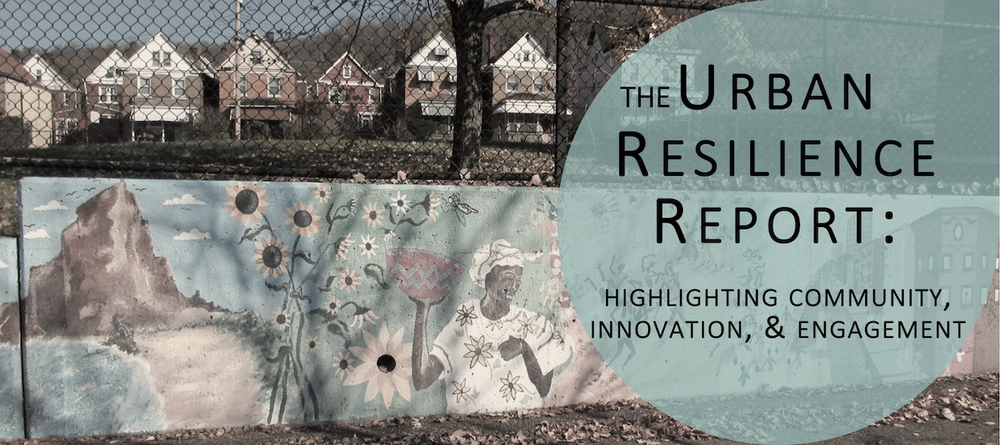Posted: October 20, 2021
Welcome to the first issue of the The Urban Resilience Report, a publication of the Center for Economic and Community Development and the Urban Resilience Working Group at Penn State. This report was born of the desire to create a platform to discuss and better understand urban community resilience.

The Urban Resilience Report
By Justine Lindemann
The concept of resilience, including urban resilience, is widely used but not widely agreed upon. That is, there are varied and sometimes competing definitions of resilience, with some scholars arguing against using the term for this very reason. Their point is that multiple definitions of resilience dilutes its usefulness as a term. Others argue that resilience is in fact useful as a "boundary" concept, or one that crosses disciplines such as sociology, economics, planning and even engineering.
As the problems facing the world become increasingly interconnected or "wicked" (problems such as climate change, food security, racial equity, and disparities in public health), how we prepare our societies and ourselves to grapple with them is more important than ever. This is all the more urgent in urban and urbanizing spaces which are now home to 55% of the world’s population and almost 85% of the US population.
The following definition of urban resilience might be a helpful starting point: “urban resilience refers to the ability of an urban system […] to maintain or rapidly return to desired functions in the face of a disturbance, to adapt to change, and to quickly transform systems that limit current or future adaptive capacity” (pp. 315).
Let's break this definition down and think about the implications for an engaged urban praxis (practice informed by scholarly or philosophical knowledge, or simply, knowledge put into action.) An "urban system" here is broad. The full quote references "socio-ecological and socio-technical" aspects, which include animals (human and nonhuman), plants, roads, parks, technology, buildings, and the relationships that connect them. Achieving resilience within this broad system takes into consideration changes over time and space, and how an urban system adapts or transforms in the context of those changes.
In our framing of urban resilience as it relates to urban praxis, we ask the question, "Resilience for whom?" to highlight that resilience can exist on different scales or benefit different groups. Are corporations resilient or are communities and individuals resilient? Which groups are better positioned to thrive in the face of systemic shocks and stresses, and how can we – as academics, practitioners, and community development professionals – support and build that capacity?
A resilience framework can be a useful tool for extension professionals and other practitioners to understand challenges to and opportunities for building community well-being in urban areas. Trying to achieve resilience in every aspect of community simultaneously might be daunting, so it may be useful to think about building resilience through various entry points, or dimensions, of an urban system. While these dimensions are interrelated, we can identify aspects such as the built environment (general infrastructure, buildings, wastewater treatment, levees and seawalls, etc.); population and governance (equitable resource distribution); social relations (vulnerable, children, elderly, foreign, disability, uninsured, unemployed, religion, crime rate, income); and economic relations (GDP, income per capita, employment, jobs, industry, property values) (Torres and Alsharif 2017; Cafer et al, 2019).
Returning to the question of "resilience for whom" points to a praxis (again, action informed by knowledge) that emphasizes building community resilience through democratic and equity-oriented engagements. An equity lens on community resilience asks which groups are most impacted by a particular challenge (say, the heat island effect) and engages those groups directly in determining pathways to resilience. The process of building resilience should be community driven and co-created, however implementing solutions may involve residents to a greater to lesser degree. For example, expanding tree canopy cover or installing rain gardens for managing stormwater runoff might be a community engaged process while implementing green roofing systems may depend upon the financial support and policy decisions of local government.
The challenge of how to integrate resilience into urban systems thus remains. That is, what role for Extension, for researchers, for community development practitioners? How do these groups build the necessary relationships across urban systems to effectively operate in those spaces? The Urban Resilience Report will explore these questions by highlighting work that has the potential to or is currently supporting community resilience through a democratic, equity-oriented, and engaged praxis.
If you would like to receive The Urban Resilience Report in your inbox, please click here to join the listserv.

